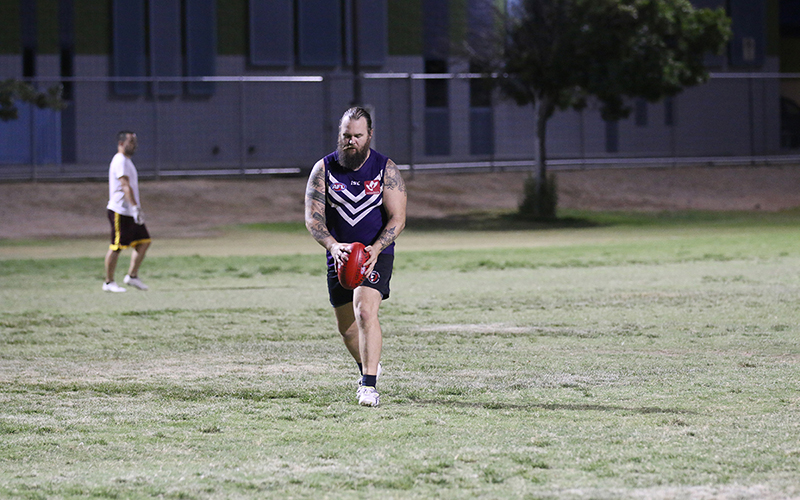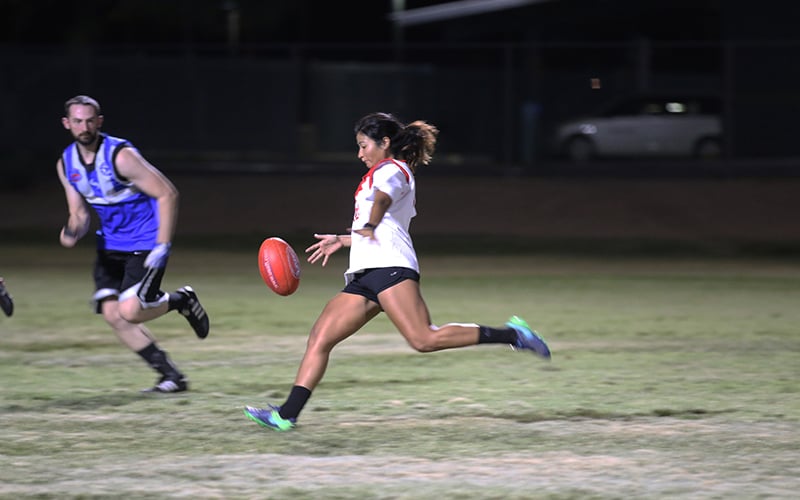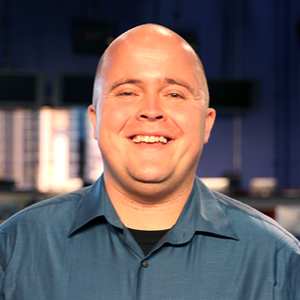
Australian Rules Football players come from a wide range of professions, including teaching history like Travis Johnson. (Photo by Cassidy McCauley/Cronkite News)

Amanda Mora played college soccer in Maine and has enjoyed the transition to Australian Rules Football. (Photo by Cassidy McCauley/Cronkite News)
TEMPE – On the field they compete against teams from all over America. Off the field they are educators, healthcare professionals and even the guy who scoops your ice cream.
What brings them together is a passion for a game they call “footy”.
Twice a week a group of athletes come together at parks across the Valley to practice Australian Rules Football, a sport unfamiliar to many. Those who play it often come away bloodied and bruised. And then they go raise a brew to celebrate.
“It is more than just playing a sport,” said Peter Abernathy, a data analyst from Scottsdale and member of the Arizona Outlaws, an Australian Rules football club. “There is more of a social atmosphere to it compared to the other sports I play.”
Played without padding or helmets, Australian football demands physicality. It combines elements of American football, soccer, rugby and even basketball into one sport.
“It combines all that you got in your arsenal and you apply it to one sport. It’s great,” said Robert Lutostanski, a water-chemical specialist from Tempe and president of the Outlaws.
Played on an oval field much larger than an American football field or even a soccer pitch, the game matches teams of 18 on each side with up to four reserves. Games consist of four 20-minute quarters, with extra time added for stoppages much as in soccer.
The object is to move the ball, which resembles a rugby ball and is about twice the size of a football, by running with it, bouncing it, kicking it or by holding it in one hand and punching it with the other – something called a handball. The rules allow tackling and certain types of blocking.
To score, a player must kick the ball through a pair of primary goal posts for six points. Kicking the ball outside those posts but inside a secondary set of posts is good for one point.
At the start of games and after a team has scored, an official bounces off the ground high into the air and two opposing players try to tip it to a teammate, much like a basketball center jump.
“It is definitely a touch of every single product, highlighting every American sport,” said Andrea Placencio, a Medicare manager from Mesa and one of a handful of women who play for the Outlaws.
Despite the physical nature of the sport, which often leaves players with sprained ankles and numerous scrapes, cuts and abrasions, the players stress safety and do their best to prevent serious injury.
“There’s no slide tackles or anything above the shoulder,” Lutostanski said. “So a lot of people don’t know that there are less injuries in our sport (than the American version).”
Footy in Arizona
Since its inception in the mid-1800’s, Australian Rules Football has been played globally and now has piqued the interest of some in the Valley looking to remain active and try something new.
Footy gained a foothold in Arizona about 20 years ago and has had teams in Tucson, Chandler, Scottsdale and others. Anthony Starks, who now lives in Phoenix, founded the now-defunct Tucson Javelinas after falling in love with the game in 2001.
“We ended up practicing all summer long before entering the league,” Starks said.
The competition between Arizona’s teams flourished for the next few years. After a falling out with the United States Australian Football League, a non-profit dedicated to growing the development and growth of the sport, members in the local footy community were able to mend the relationship and now the Outlaws and Arizona Hawks are among 45 teams in the USAFL.
The Hawks, who began play in 1999, were that state’s first team but folded as some players stepped away from the game.
“Things change and people move away,” Starks said. “Careers, wives, kids, injuries, you know life.”
For the next decade, organized footy remained inconsistent in Arizona until the Hawks began to practice again in 2015. The Arizona Outlaws began to take shape in 2017. Their players also compete in the four-team Arizona Footy League, a Valley league they competes with nine-player teams.
“We’ve laid out a great foundation and groundwork for Arizona footy leagues for years to come,” Starks said.
The recruitment
One of the biggest problems footy players face is recruiting new athletes to clubs. As numbers fluctuate, members are focused on attracting a younger generation of players into the fold to keep the game growing.
“You want to play a great sport and apply all of those skills (from other sports),” Lutostanski said. “(If) you’ve got great hand coordination and eye coordination, you name it, you’re wanted.”
The Outlaws, who have 35 members, always welcome newcomers.

Australian Rules Football combines elements of American football, soccer, rugby and even basketball into one sport. (Photo by Cassidy McCauley/Cronkite News)
“We are a tight group of people. We are more than happy to have anybody that wants to come out,” Lutostanski said.
Starks believes the older generation of footy players have a responsibility to recruit and educate new players in an effort to keep the club going for years to come.
“It’s just a matter of finding those guys, breaking down those barriers, so they’re not afraid to say, ‘Okay, I’ll try something new,’ ” Starks said.
Abernethy was looking for new ways to remain fit when he was enticed by a coworker to watch a footy practice. Now nearly a year later, he hasn’t missed an event yet.
“It is definitely a cool sport,” Abernethy said. “You might have a grudge on the field but afterwards everyone goes out for a drink.”
Abernethy stressed that anyone who has reservations about trying the sport will find that they can adjust quickly.
“Anyone can play as long as you’re hustling and trying,” he said. “Everyone can be really good at it.”
Women’s “Footy”
The sport is also growing among women and the USAFL has begun to build an all-women’s league. Organizers hope to recruit some of the best athletes in the area to play on an Arizona team.
After more than a decade in the sport, Placencio sees the difficulty of recruiting other women, but remains hopeful.
“I would love to support the growth of a women’s team,” Placencio said. “We have some youth coming in, and it’s just beautiful.”
As a veteran presence on the Outlaws, Matthew Lambert, a maintenance supervisor from Gilbert, is determined to build the women’s team. Seven women regularly workout with the club, and the goal is to build a team of 30.
“I want us to have the best women in the competition,” Lambert said. “We want a diverse team, and we want to work together to build this.”
One woman from the Outlaws that is making waves is Amanda Mora, an occupational therapist from Phoenix. After having a successful career in college soccer in Maine, Mora was introduced to footy by recreational soccer players she was playing with and quickly adapted to the new sport.
“It was a really positive environment and everyone was super helpful teaching you the game,” Mora said.
She believes that increasing the number of women in the sport in Arizona should be a priority and wants to show that footy is safer than many other sports.
“It is really not anything dangerous,” Mora said. “I’ve had more injuries playing soccer than I have footy.”
Relationships with cities
Ultimately, Arizona’s footy enthusiasts hope to build from the four-team conference in place now to a league of teams representing different cities in the state.
“We want to build a metro competition that encompasses all of Arizona,” Lambert said. “So we are talking about stretching into places like Tucson and Flagstaff.”
Their overall goal is to grow the sport throughout the state and build a foundation that makes Arizona a footy powerhouse in the USAFL
“We want to beat them, and the only way to beat them is to expand the sport in our zone,” Lambert said.
What the Arizona footy community doesn’t have is its own field. A regulation field, according to the USAFL.com, is between 135 and 185 meters in length and 110 to 155 meters in width. The only fields Arizona clubs are able to reserve are soccer fields, which are 120 meters long and 90 meters wide.
Forced to adapt their rules to smaller fields, the Outlaws hope to build relationships with cities and work to make adjustments at a public park that can accommodate a full footy field.
“That was one of the many problems that we had,” Starks said. “There were fields, but they would not rent them to us to use them.”
With no permanent field, the local clubs must set up their field from scratch whenever they play. Having their own field would not only give the club’s a permanent home, but would make setting up for competition quicker.
“Hopefully in the future, the cities will help us and kind of help encourage the sport to make it more of a user-friendly field,” Lutostanski said.
Hosting events in the future
And Arizona has advantages for the sport.
With dry weather, the Outlaws can be an asset to the USAFL. Many of the league’s teams are unable to play in the winter because of wet fields, while clubs in Arizona play year around.
“It has so much potential,” Placencio said. “Arizona has some beautiful weather right now.”
Locals have played host to the Rob Dollar Memorial Cup tournament for the last two years. Teams come from neighboring states to compete in the event, which honors their friend who was killed in a bicycle accident two years ago. In that respect, organizers want the tournament to be about competition, but also about creating a fun atmosphere.
“People are hearing about this tournament we’ve created here,” Lambert said. “We’ve got music playing, a lot of different foods and we make it fun.”
As the tournament continues to grow, the Outlaws hope to increase their numbers enough to make it one of the biggest tournaments in footy outside of regional and national tournaments.
“We want the biggest and best tournament,” Lambert said. “We want something special for Arizona.”

